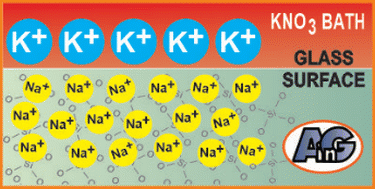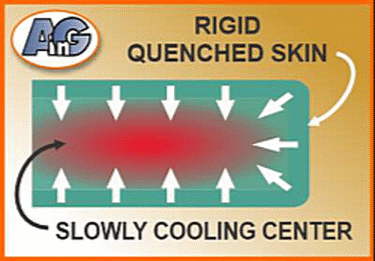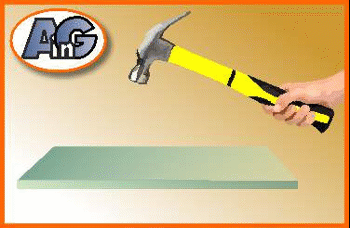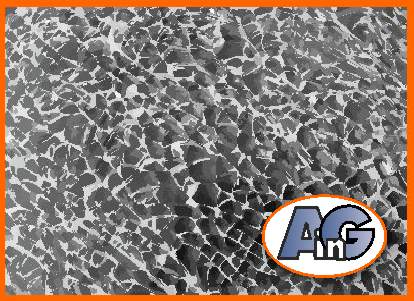Chemically strengthened glass is similar to tempered glass in that its surface is in a state of compression. The effect, however, is not caused by heating and cooling but by a chemical (ion exchange) process.
The ion-exchange process
Glass is submerged in a bath containing potassium nitrate heated to about 570 °F (300 °C ) causing the sodium (Na+) ions on the surface of the glass to be replaced by larger potassium (K+) ions. It is the extra volume of the K+ ions, packed into the space vacated by Na+ ions that created the state of compression and hence the strength of the surface.
Cramming large K+ ions into the glass also serves to seal surface imperfections that are likely to propagate cracks.

The most famous brand of chemically strengthened glass is Gorilla® Glass made by the Corning® Glass company. Similar products include Dragontrail™ glass made by the Asahi Glass Company and Xensation® made by the Schott company. (Xensation is the first generation of amazing foldable glasses for smartphones and other electronic devices.)
Corning claims that their latest Gorilla glass (Glass Victus®) routinely survives drops from up to 2 meters (6 1/2 ft) onto hard surfaces without breaking and that it is also twice as scratch resistant as competitors’ products.
As an Amazon Associate, I earn from qualifying purchases
The story of Gorilla Glass and the genius of Steve Jobs
An interesting story about the scratch resistance of glass came during the design of the first iPhone in 2007. Steve Jobs was on his way to the New York Times with a prototype iPhone in his pocket during the pre-launch period and was irate when he noticed that the plastic screen had become scratched by rubbing against coins and keys in his pocket.

Steve ordered his design team to develop a glass screen in only six weeks. The shocked designers told Steve – glass is too risky – if the iPhone is dropped, the screen will smash because glass is brittle.
But Jobs was insistent – and he used the following, very perceptive, reasoning:-
“if the screen is scratched by keys and coins the customer will blame Apple for a design fault: however, if the screen breaks because the phone is dropped onto a concrete floor – the customer will consider this to be his fault – and blame himself not Apple“
The frantic engineers contacted the Corning Glass Company which developed specially toughened glass called Gorilla glass in record time. The new glass was sent to China and engineered in time for the much-heralded product launch. Steve cemented his reputation as being almost impossible to work for but extremely smart.
Several generations of Gorilla glass have been developed and financed by cooperation between Apple and Corning. Billions of smartphones, iPads, and similar devices now use chemically tempered glass screens.
Top-selling laser-cut tempered glass, exquisitely polished with rounded edges to protect your iPhone. Sizes are available for all smartphone models,
Chemically strengthened vs tempered glass
Chemical strengthening is the only option for tempering if the required sheets are small, thin, and have complex shapes.
Size limits for chemically strengthened & thermally tempered glass
| Chemical | Thermal | |
| Max size | about 30″ * 36″ | > 60″ * 144″ |
| Min size | about 1 sq in | about 1 sq ft |
| Max thickness | 3/4″ | 1″ |
| Min thickness | 0.30 mm (0.12 in) | 3.0 mm (1/8 in) |
| Cost | Expensive | Inexpensive |
Chemically strengthened glass
In summary: chemically strengthened (also known as chemically tempered) glass offers more impact resistance, improved flexibility, improved scratch resistance, and improved resistance to temperature changes.
Generally speaking, chemically strengthened glass retains the same optical properties (refractive index), color, clarity, and transmissivity as regular annealed glass.
Furthermore, chemically strengthened glass can be machined after tempering, unlike thermally tempered glass. See this post for an explanation of why tempered glass cannot be cut, drilled, or machined.
Thermally tempered glass
Thermally tempered glass is the most important type of safety glass and is used widely in architectural applications to provide safe windows, glass doors, shower enclosures, tabletops, railings, and many other applications.
The strengthening of the surface layer is analogous to that of chemically strengthened glass:


Unlike chemically strengthened glass, tempered glass cannot be cut or drilled – it will break into numerous harmless fragments,

Chemically strengthened glass – summary
Chemically strengthened or chemically tempered glass is one of the miracle products of the 21st-century – permitting the inexpensive production of robust screens for hi-tech devices and furthering the digital revolution.
In chemically strengthening smaller Na+ ions are replaced by larger K+ ions in a process called ion exchange. The extra volume of the K+ ions, packed into the space vacated by Na+ ions, creates the state of compression and hence the strength of the surface.
Glass safety – learn from the experts!
- Choosing between tempered & laminated glass
- Broken glass injuries and how to avoid them
- Is wired glass safe?
- What is safety glass?
- What is tempered glass?
- What is Gorilla Glass?
- Plexiglass vs glass
- Should glass shelves be tempered?
- Should glass tabletops be tempered?
- Is lead crystal dangerous?
- Is leaded (stained) glass dangerous?
- How to repair cracked stained glass
Glass tabletops & shelves – info from Artistry in Glass
- Benefits of glass shelving – info from experts!
- How much do glass tabletops cost?
- Do glass shelves need to be tempered?
- What is the best thickness for glass shelves?
- Best edge type for glass shelves, polished or beveled?
- How much weight can a wall shelf carry?
- What color glass should my shelves be?
- Glass tabletops – 10 amazing benefits explained
- How to order a glass tabletop
- Best thickness for glass tabletops – expert advice
- Should glass tabletops be tempered?
- Should glass tabletops be beveled?
- How to paint a glass tabletop
- All about tempering glass tabletops!
- How to tell if your glass is tempered
- Can tempered glass be cut?
- How to protect your wood table with glass
- How to fix a scratched glass tabletop
- How to fix a chipped glass tabletop
- How to replace broken patio table glass
- How to measure for a glass tabletop
- Video – how to measure your tabletop
- Plexiglass vs glass – pros and cons
- Beveled glass table base – a case study
- Choosing between tempered & laminated glass
- Glossary of terms used in the glass business


